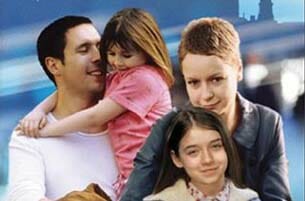Jim Sheridan is an Irishman through and through. Even though he moved his wife Fran and two daughters to New York in the ’80s and has lived there ever since, he remains a storyteller preoccupied with the dilemma of Ireland’s divided soul. All of his films have explored the chasm between Catholic and Protestant, between Ireland’s painful past and possible futures, in vivid and memorable ways.
My Left Foot brought to life the sufferings and inspiring spirit of painter/poet Christie Brown, and introduced many viewers to the formidable talents of Daniel Day-Lewis. In the Name of the Father delivered more Oscar-worthy performances by Day-Lewis and Pete Postlethwaite in a story about IRA bombings and the wrongfully accused Gerry Conlon. Into the West, which Sheridan wrote and Mike Newell directed, remains a sorely underrated family adventure film, in which two Irish boys discover a mythical horse and run from the pain of a lost parent. The Boxer focuses on the efforts of one man (Day-Lewis again) to bring warring factions together in a community endeavor.
And now, Sheridan just may have his masterpiece.
In America is a semi-autobiographical account of a family trying to recover from a death by making a new start in the States. Bedraggled and broken, the family arrives in Manhattan with very few dollars and enormous dreams.
The film manages to be many things. It’s an honest account of a family’s survival and the trials and triumphs of tough love. Small children contend with grownup-sized problems. Their parents struggle with things they can’t control, trying to maintain a spirit of childlike wonder even in the face of real-world trials such as unemployment and insurmountable hospital bills. And somehow Sheridan finds room to examine the experience of immigrants, AIDS patients, struggling artists, pregnant mothers, and fathers losing faith in both themselves and God.
The film also presents us with a true cinematic rarity: an admirable married couple. Paddy Considine (24 Hour Party People) and Samantha Morton (Sweet and Lowdown, Minority Report) portray Johnny and Sarah, a convincingly complex, committed, flawed and sexy Irish couple. Their two daughters Christy and Ariel (played to perfection by the marvelous sister team of Sarah and Emma Bolger) capture the kind of delightful, inquisitive moments that most parents treasure in memory. You would be hard-pressed to think of another recent film that demonstrates family life with such guts and honesty.
Through close attention to detail, Sheridan draws suspense and humor from the emotional journeys of each character. After their illegal entry into the U.S., Johnny and Sarah move their family into a dilapidated apartment building populated by junkies and rough-edged neighbors. They struggle to pay bills, endure humidity and overcome unexpected challenges to their health.
Their burdens are etched in Johnny’s furrowed brow; he refuses to believe a benevolent God could have allowed their family such sufferings. Sarah wrestles too, but in a quieter way, burying her true feelings behind a forced performance of happiness for the sake of her impressionable children.
Paddy Considine makes Johnny a man whose feverish dedication to survival and family is at once endearing and alarming, especially as he becomes increasingly blind to the impact his anger and unresolved grief have upon his children. Samantha Morton brings the same intensity to Sarah that she brought to the lead role in last year’s overlooked Morvern Callar.
If Sarah is introspective, her 11-year-old Christy is more so. Christy narrates the story, occasionally condensing chapters of the family history by showing highlights from her precious handicam, which brings a documentary flavor to many memorable moments. It’s startling when she steps out from behind her observant pose, suddenly unloading frustrations that betray how quickly she’s being forced to grow up.
Through it all, Christy’s younger sister Ariel skips like a guardian angel, her innocence humbling her parents and neighbors, her questions naïve yet profound, her spirit undimmed by loss. Emma Bolger’s performance is the most astonishing by a young girl since the brilliant turn by Victoire Thivisol in Ponette.
The girls’ first American Halloween excursion, an unlikely encounter with the building’s resident artist, is one of the year’s most delightful and surprising sequences. Their “trick-or-treat” visit with Mateo (Djimon Hounsou), who has earned the nickname “The Screaming Man,” leads them to insights and blessings they never dreamed possible.
The film’s intimate nature is enhanced by poetic imagery captured by versatile cinematographer Declan Quinn (Monsoon Wedding, Leaving Las Vegas, Vanya on 42nd Street). Quinn and Sheridan avoid familiar and distracting postcard images and immerse us instead in a particular neighborhood.
In America does not end with sentiments about Providence, nor does it offer empty assurances that we can find all necessary resources within ourselves. But it does allow for the possibility that a child’s faith might not be wishful thinking after all. In fact, it suggests that only by surrendering our suppressed anger and grief can we catch our breath and find hope again. It also indicates that by blessing those who are foreign or frightening to us—by showing enough faith to embrace them—we create a larger space for love to do a work that blesses us all. Isn’t that what America is supposed to be about?
For all the film’s focus on grief and loss, the strongest impression that lingers after first viewing is the laughter it provokes: healthy, hearty laughter that casts off the pall of suffering. Where the other death-obsessed dramas of 2003—Mystic River, 21 Grams, House of Sand and Fog—let their contrived, deterministic and pessimistic plots bury any hope for humor and warmth, In America provokes both tears and joy, all of it earned.
